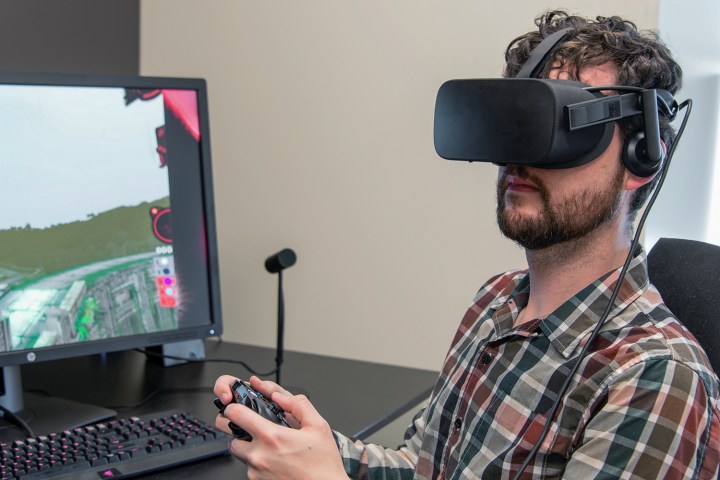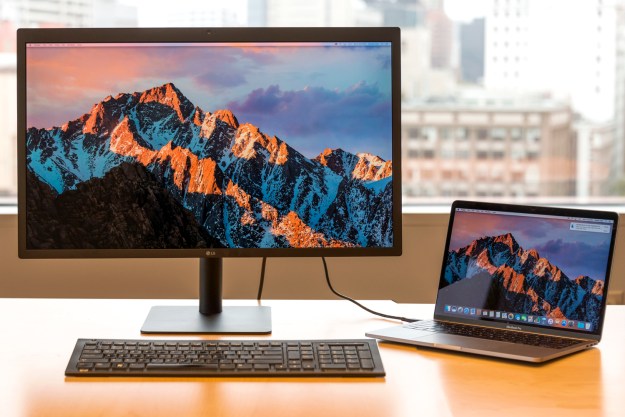
With only rumors of a new, high-end Oculus VR headset and a suggestion that Facebook may be pivoting to focus on mid-range virtual reality instead, the 2016 Oculus Rift may remain the top offering from the company for some time. That means that with the launch of the HTC Vive Pro, the Rift has to go head to head with it.
So let’s compare the Oculus Rift vs. Vive Pro — can the Rift stay competitive with a newer, sleeker version of the headset that we consider to be still the best consumer-grade VR headset you can buy?
Specifications
Oculus Rift
|
HTC Vive Pro
|
|
| Display | OLED | AMOLED |
| Resolution | 2,160 x 1,200 | 2,880 x 1,600 (615 PPI) |
| Refresh Rate | 90hz | 90Hz |
| Platform | Oculus Home, SteamVR | SteamVR, Viveport |
| Field of view | 110 degrees | 110 degrees |
| Tracking area | 5 x 5 feet (two sensors) 8 x 8 feet (three) | 100m squared (33 x 33 feet) |
| PC connection | Wired | Wired, wireless (with adaptor) |
| Built-in audio | Yes, headstrap headphones | Yes, headstrap headphones w/ in-line amplifier |
| Built-in mic | Yes | Yes, dual |
| Controller | Oculus Touch, Xbox One controller | Original Vive controller, support for new Vive controller (w/ new sensor, color), any PC compatible gamepad |
| Sensors | Accelerometer, gyroscope, magnetometer, Constellation tracking camera | Accelerometer, gyroscope, Lighthouse laser tracking system, dual front-facing cameras, support for Lighthouse 2.0 |
| Connections | HDMI, USB 2.0, USB 3.0 | USB-C 3.0, DisplayPort 1.2, Bluetooth |
| Requirements | NVIDIA GeForce GTX 960 / AMD Radeon RX 470 or greater
Intel Core i3-6100 / AMD FX4350 or greater 8GB+ RAM Compatible HDMI 1.3 video output 2x USB 3.0 ports Windows 7 SP1 or newer |
Nvidia GTX 1060 / AMD Radeon RX 480 equivalent or greaterIntel Core i5-4590 equivalent or greater
4GB+ of RAM DisplayPort v1.2 1x USB-A 3.1 port Windows 8.1 or Windows 10 |
| Price | $400 | $1,100 ($800 for headet only) |
| DT review | 3 out of 5 stars | 3.5 out of 5 stars |
Design
One of the starkest differences between the Oculus Rift and the original HTC Vive is how the two headsets looked and that’s no different with the Rift and Vive Pro. While the Oculus headset has a sleek, fabric covering, the Vive Pro retains it’s predecessor’s hard, plastic shell — albeit with a newly tinted paint job. Although you could argue that that makes the Rift the sleeker looking device of the two, it makes no functional difference.
The headstraps on each headset are more alike, with both featuring a semi-hard plastic shell to fit your head into. Where the Rift utilizes velcro straps to adjust length and fit though, the Vive Pro has the same turn-dial as the HTC Deluxe Audio Strap for the original Vive. It’s a neater solution that provides a better fit overall and when combined with alterations that let you tweak the distance between the interior lenses and the user’s eyes, makes the Vive Pro a better fit for those with glasses too.
Both headsets have built-in headphones which can be detached and bent away from the ear to make it easier to hear what’s going on around you. The Vive Pro features two front-facing cameras for pass-through video and potentially controller tracking. The Rift features no-such eye to the outside world.
In our review we thought the Vive Pro felt about as heavy as the original Vive, which means the Rift is still likely the lighter of the two. However, the Vive Pro’s improved headstrap, weight distribution, and augmented face pad means it will likely be more comfortable over longer periods. It also features improved light blocking, which was a noticeable issue with the Rift’s padding around the nose.
Although we may have preferred the Rift’s design over the original Vive’s, some neat upgrades and augmentations in the Vive Pro make it our pick for the better designed of the two headsets.
Winner: HTC Vive Pro
Display quality, field of view
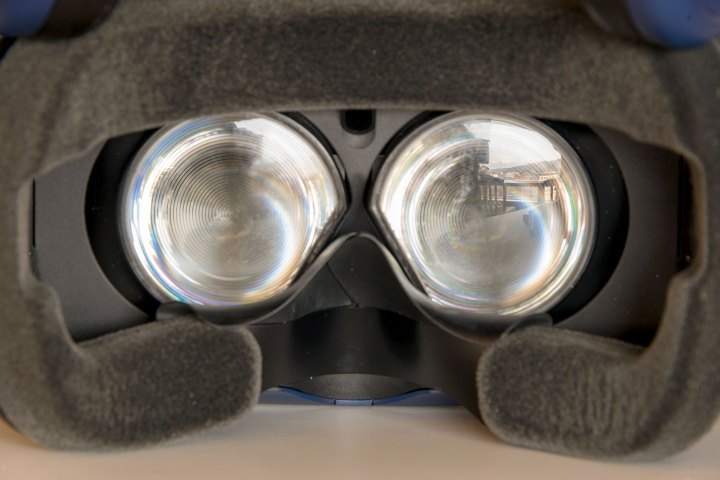
Considering the HTC Vive featured better optics and a slightly improved field of view (with some scientific evidence to back it up) than the Oculus Rift, it’s fair to say that the Vive Pro widens that gap considerably.
Although its lenses are the same fresnel design with the same visual artifacts in high-contrast scenes, its newly detailed AMOLED displays mark a stark improvement over the Rift’s. The resolution of the Vive Pro’s dual panels is 2,880 x 1,600, a near 80 percent increase in pixels over the Rift’s. That translates into sharper visuals up close and at distance, and a reduced screen door effect.
Refresh rates across both headsets are the same, but the newer display technology and increased pixel density of the Vive Pro easily make it the better visual experience.
Winner: HTC Vive Pro
Controls and tracking

The HTC Vive Pro debuted with support for new trackers and controllers, but they won’t be out until later in the year. The original Vive’s wands were arguably less impressive than the Rift’s more compact and versatile Touch controllers, though the Vive Pro’s support for Lighthouse laser trackers certainly gives it an advantage over the Rift thanks to better roomscale tracking.
When the second-generation Lighthouse trackers are released later on in 2018 though, the Vive Pro will pull ahead once again. Lighthouse 2.0 will feature support for up to four sensors for more accurate tracking and better redundancy for occlusion. They will also operate at up to 33 x 33 feet, which is more than four times as large an officially supported playspace than the Oculus Rift’s. Although that’s not a tracking space that many will be able to utilize, it means that the Vive Pro will be a much better choice for those with huge play areas and commercial enterprises looking to enable large-scale multiplayer games.
The new Vive Pro controllers won’t be such an upgrade. They’ll use the same form-factor as the originals and merely come with a new paint job and upgraded sensors for the Lighthouse 2.0 system.
As much as both old and new tracking systems for the Vive Pro will be a step up from the Oculus Rift’s Constellation cameras, the new official HTC wireless module will let the headset climb a story higher. Although an optional upgrade for the Vive Pro (and original Vive) not set to be released until later this year, it will make it possible to ditch wires altogether with no lag. That will give rise to new battery life concerns, but wireless headsets (as Oculus is doing with the Go) are a true, second-generation upgrade that will be a major selling point for adopters.
While the Rift may remain competitive in terms of motion-inputs, its tracking system was weaker than the original Vive’s. When Lighthouse 2.0 is out, that system and the forced wire tether will seem quite antiquated in comparison.
Winner: HTC Vive Pro
Audio

The Oculus Rift’s headphones were a welcome addition compared to some of the competition it faced at the time. Those headphones remain comfortable, functional and reasonably loud today. They aren’t the highest of quality and most audiophiles would want to replace them with something better, but it means that your purchase comes with a decent audio solution right out of the box.
That same can be said for the Vive Pro now. HTC has included a powerful amplifier in its new headset and the headphones are Hi-Res certified, so can provide decent audio experience, but we found it a bit abrasive at higher volumes. Serious sound-buffs will want to use their own headphones, as the sound is far from perfect, but it’s a big upgrade over the original Vive’s earbuds. The headphones are also removable, which is a useful feature.
In terms of audio input, the Vive Pro is definitively more impressive, as it comes fitted with a new dual-microphone array, better support for conversing in and out of the VR world, and active noise cancelling. It also comes with physical audio switches for volume control and mute on the headset itself, so you don’t have to dive into the SteamVR menu to change those settings.
The Rift has a single built-in microphone which is functional, but far from exceptional.
Winner: HTC Vive Pro
Performance and requirements
The HTC Vive Pro has higher-resolution demands than its predecessor, so it has higher minimum and recommended requirements. Although SteamVR now supports automated supersampling (up and downscaling) to match your system’s hardware, the Vive Pro’s demands are certainly higher than that of the Oculus Rift’s.
Frame rates across both headsets are the same though, due to stringent requirements of consumer VR and the 90Hz refresh rate of both headsets.
Winner: Oculus Rift
Software

The differences between Oculus VR’s and HTC’s software platforms are far less obvious today than they were when both companies launched their first VR headsets. Both have access to an expansive library of titles through Steam using the SteamVR protocol. Oculus also has its own software platform with Oculus Home, while HTC and its Vive Pro has the VivePort store and subscription program.
The Vive Pro has access to a slightly wider array of games and experiences thanks to larger roomscale tracking and longer embedding of SteamVR support, but Oculus isn’t resting on its laurels. Its recent Rift Core 2.0 update massively expands the capabilities of the Home space and its new Dash menu system makes it easier to interact with non-VR applications while in VR. Facebook is likely to continue to push social content through its Oculus headsets too, which will be a real boon to those who want to use virtual reality for those kinds of interactions.
Both headsets have something going for them in this respect. The Oculus Rift’s “home” is arguably a slightly more polished experience, but the Vive Pro has a greater library of titles — especially if some are crafted to specifically take advantage of its new tracking abilities in the future.
Winner: Draw
Pricing and availability
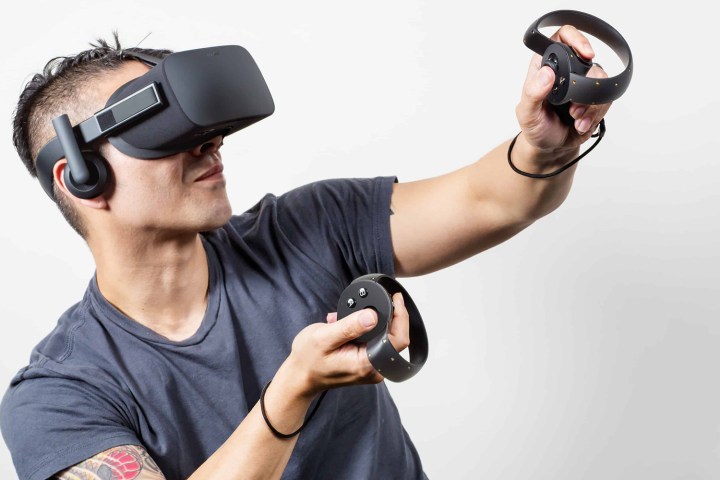
The Oculus Rift with Touch controllers is currently priced at $400 and can often be found at $350 during sales, making it substantially cheaper than the HTC Vive Pro, which for the headset alone is $800. Buying it with first generation Vive motion controllers and Lighthouse sensors will set you back $1,100 in total. It is likely to be more expensive again when the second generation trackers and controllers launch later in 2018.
While we still might counsel you to buy an original HTC Vive (for $500) if you want a more affordable VR solution, when compared with the Vive Pro, the Rift is a much more economical entry point for high-end VR.
Winner: Oculus Rift
Overall Winner: Vive Pro
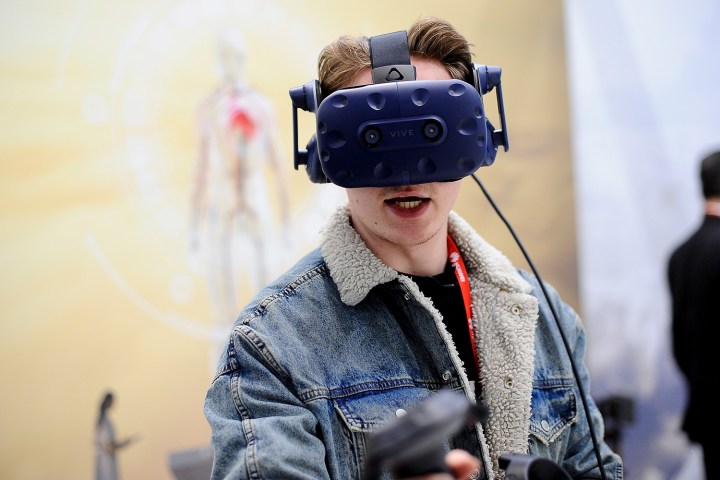
Considering it’s coming up on its second birthday, an age in any high-end hardware space, the Oculus Rift is aging fairly well. Its expanded software palette and ever-shrinking price tag make it a viable option for those looking to get into PC-based virtual reality.
That said, it is starting to show its age in the hardware department. Its lower-resolution display, lack of a wireless option, and (comparatively) limited roomscale tracking are in stark contrast to the more powerful HTC Vive Pro. Oculus will need a second-generation Rift of its own that goes far beyond the Oculus Go, to effectively respond to this new top-tier headset and some of the other competitors waiting in the wings.
Editors' Recommendations
- Google Drive vs. Dropbox: which is best in 2024?
- JPEG vs. PNG: When and why to use one format over the other
- MacBook Pro battery replacement: everything you need to know
- How the Vive XR Elite can do high-end VR in a half-pound headset
- Dell XPS 15 vs. Razer Blade 15: which to buy in 2022




